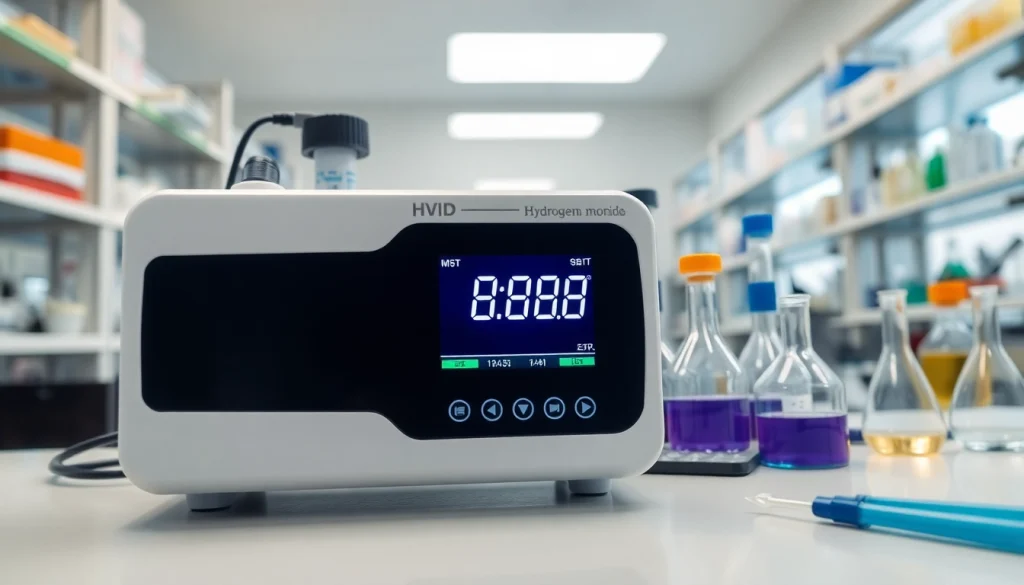Understanding Hydrogen Peroxide Monitors
What is a Hydrogen Peroxide Monitor?
A Hydrogen Peroxide monitor is a specialized device designed to detect and measure the concentration of hydrogen peroxide in the air. Hydrogen peroxide (H₂O₂) is a powerful oxidizing agent widely used as a disinfectant, sanitizer, and bleaching agent in numerous industries, including healthcare, food processing, and pharmaceuticals. Employing a reliable hydrogen peroxide monitor is crucial for ensuring safety in environments where high levels of this chemical may pose significant health risks.
These monitors are engineered to provide real-time data, alerting personnel when hydrogen peroxide reaches hazardous thresholds. Implementing such a device not only enhances workplace safety but also aids in compliance with health regulations. Hydrogen Peroxide monitors are essential in various applications, from hospitals to food manufacturing plants, where maintaining the right disinfection levels is critical.
How Do Hydrogen Peroxide Monitors Work?
Hydrogen peroxide monitors typically use electrochemical sensors, photoionization detectors, or catalytic sensors to gauge H₂O₂ levels in the environment. Here’s a brief overview of how each type works:
- Electrochemical Sensors: These sensors operate by detecting changes in electrical current proportional to the concentration of hydrogen peroxide in the air. When H₂O₂ comes into contact with the sensor, it undergoes an electrochemical reaction that generates a measurable electric current.
- Photoionization Detectors (PID): PIDs work by utilizing ultraviolet light to ionize hydrogen peroxide molecules in the air. The resultant charged particles produce a measurable current, which corresponds to the hydrogen peroxide concentration.
- Catalytic Sensors: These sensors employ a catalytic surface to promote a chemical reaction with hydrogen peroxide, generating heat as a byproduct. This heat change is measured and indicates the concentration of H₂O₂ present.
Most monitors also feature built-in alarms and logging capabilities, enabling facilities to keep historical data and respond efficiently in case of elevated hydrogen peroxide levels.
Applications of Hydrogen Peroxide Monitoring
Hydrogen peroxide monitoring finds its primary applications in various industries due to the compound’s broad utility and associated risks. Here are some key sectors where these monitors are especially important:
- Healthcare: In hospitals and clinics, hydrogen peroxide is frequently used for sterilization. Monitors ensure that H₂O₂ levels remain within safe limits to protect patient and staff safety.
- Food Processing: In food manufacturing, hydrogen peroxide is applied for surface sanitation. Proper monitoring ensures that food safety standards are upheld during the various stages of production.
- Pharmaceuticals: The pharmaceutical industry utilizes hydrogen peroxide for cleaning and sterilizing equipment and facilities. Accurate monitoring is vital to meet stringent regulatory standards.
- Aerospace and Defense: Hydrogen peroxide serves as a propellant and cleaning agent in various aerospace applications. Monitoring levels in such settings is crucial for both operational efficacy and safety.
Importance of Accurate Monitoring
Health Risks of Hydrogen Peroxide Exposure
While hydrogen peroxide is effective for sanitization, improper handling can pose serious health risks. Short-term exposure to high concentrations can lead to respiratory issues, skin irritation, or eye injury. Prolonged exposure may result in more severe health consequences, including pulmonary damage or systemic toxicity. Therefore, accurate monitoring is necessary not only to prevent acute incidents but also to protect against chronic health complications.
Key Benefits of Constant Monitoring
Implementing hydrogen peroxide monitors brings multiple benefits to facilities:
- Enhanced Safety: Continuous monitoring allows for immediate action when hydrogen peroxide levels exceed safe thresholds, protecting employees and others in the vicinity.
- Regulatory Compliance: Many industries must adhere to strict safety regulations regarding hazardous substances. Accurate monitoring ensures that facilities meet, and often exceed, these requirements.
- Increased Operational Efficiency: By ensuring that disinfection is adequately maintained, organizations can prevent downtime caused by accidents or health-related incidents, thereby promoting workflow continuity.
Case Studies: Success with Hydrogen Peroxide Monitors
Consider a hospital that experienced a spike in surgical site infections. After investigating the source, they discovered inadequate hydrogen peroxide vapor levels in sterilization rooms. By implementing hydrogen peroxide monitors, they ensured optimal sterilization conditions, leading to a significant drop in infection rates. This success story underscores the importance of real-time monitoring in maintaining hygiene standards and protecting public health.
Choosing the Right Hydrogen Peroxide Monitor
Essential Features to Consider
When selecting a hydrogen peroxide monitor, several crucial features should be prioritized:
- Response Time: Quick response times are vital in environments where rapid changes in concentration can occur. Look for monitors that provide instant feedback to ensure timely actions can be taken.
- Detection Range: Depending on the application, you may need a monitor that can detect low parts per million (ppm) as well as higher concentrations. Ensure the monitor fits the specific requirements of your facility.
- Data Logging and Reporting: Monitors with data logging capabilities enable facilities to track trends over time and maintain compliance documentation easily.
- Portability and Size: Depending on the environment, portable monitors may be necessary for flexibility, while fixed monitors provide stability and reliability in high-risk areas.
Top Brands and Models Reviewed
Several top brands specialize in hydrogen peroxide monitoring, each offering various models suited for different applications. When considering what to purchase, look into renowned brands like:
- Honeywell: Known for its durable design and fast response times, Honeywell’s hydrogen peroxide monitors are widely used in healthcare settings.
- RAE Systems: Their photoionization detectors are praised for their precision and reliability in detecting volatile compounds, including hydrogen peroxide.
- Industrial Scientific: They provide portable monitors with advanced data logging capacities, ideal for industries with rigorous safety demands.
Comparative Analysis of Pricing and Performance
When evaluating hydrogen peroxide monitors, price ranges can vary significantly based on features, brand reputation, and performance. Typically, monitors can range from a few hundred to several thousand dollars. It’s advisable to balance cost with performance specifications, paying attention to critical factors like sensor type, calibration frequency, and warranty. Investing in a high-quality monitor can significantly reduce risks associated with hydrogen peroxide misuse and ensure facility compliance.
Best Practices for Implementation
Installation Guidelines for Hydrogen Peroxide Monitors
Proper installation of hydrogen peroxide monitors is essential for accurate performance. Follow these guidelines for effective setup:
- Location: Install monitors near potential high-concentration areas, such as sterilization rooms, to capture accurate readings.
- Height: Position the monitor at or above the average breathing zone of workers to ensure reliable air quality measurements.
- Calibration: Regular calibration ensures that the devices maintain accuracy over time. Follow the manufacturer’s guidelines for calibration frequency and procedure.
Routine Maintenance Tips
To ensure the longevity and accuracy of hydrogen peroxide monitors, routine maintenance is vital. Consider the following:
- Regular Inspections: Schedule routine inspections to check for wear and ensure all components are functioning correctly.
- Battery Life: Monitor battery life if the device is portable. Replace batteries as needed and keep a log of replacements to ensure availability.
- Cleanliness: Keep the monitor’s sensors clean and free from contaminants that could affect readings.
Training Staff for Effective Use
Equipping staff with the knowledge and skills to use hydrogen peroxide monitors effectively is crucial. Implementing a training program should include:
- Understanding the Risks: Ensure all personnel understand the potential hazards associated with hydrogen peroxide and the importance of monitoring.
- Operating Procedures: Train staff on how to operate the monitors, including how to interpret readings, reset alarms, and perform maintenance checks.
- Emergency Protocols: Outline clear emergency procedures for when hydrogen peroxide levels exceed safe limits.
Performance Metrics and Compliance
How to Measure Effectiveness of Monitoring
Measuring the effectiveness of hydrogen peroxide monitoring involves several key performance indicators:
- Response Accuracy: Assess how accurately the monitor detects changes in hydrogen peroxide concentrations compared to calibrated standards.
- Alarm Functionality: Test alarm mechanisms to ensure timely alerts during hazardous situations.
- Data Integrity: Regularly review logged data for completeness and correctness to ensure all monitoring data is accurate and consistent.
Regulatory Standards and Compliance Issues
Compliance with health and safety regulations around hydrogen peroxide use is paramount. Organizations should familiarize themselves with relevant regulatory bodies, such as OSHA (Occupational Safety and Health Administration) in the United States, and ensure their monitoring systems comply with established guidelines. These standards typically define permissible exposure limits and monitoring procedures to maintain a safe working environment.
Future Trends in Hydrogen Peroxide Monitoring
As technology continues to evolve, so do the methodologies for monitoring hydrogen peroxide. Emerging trends include:
- Integration with IoT: Smart monitoring systems that leverage the Internet of Things (IoT) for real-time data analytics and remote monitoring.
- Advanced Sensor Technologies: The development of more sensitive and selective sensors that can detect low levels of hydrogen peroxide accurately.
- Data Analytics: Using AI and machine learning to enhance predictive capabilities and improve safety management strategies.





